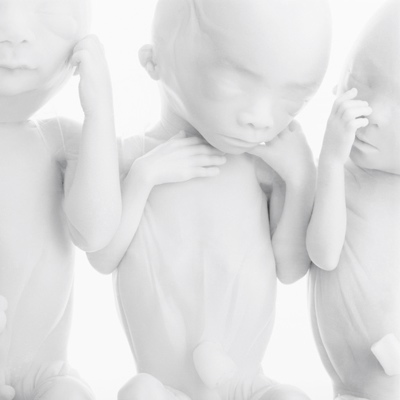September 2009
La Petite Mort Gallery presents:
Tim Porter: Still Lives / Photographs
Portraits from The Collection of The Congdon Anatomical Museum, Bangkok
September 5 – 17, 2009
Vernissage Saturday Sept 5 / 7 – 10pm
In Collaboration with the Ottawa Month of Photography
Tunes by Big Mac Daddy / Proudly sponsored by CKCU 93.1 FM
STATEMENT:
In 1988, Tokyo-based photographer Tim Porter gained access through special permission to a very privileged space: the Sirirai Hospital in Bangkok, Thailand. For one week only, he had the opportunity to photograph surreal specimens of humanity – conjoined twins. Preserved in formaldehyde and kept in the collection of the Congdon Anatomical Museum, Porter carefully shot his subjects through their glass cocoons, eliminating all traces of location, time and place.
At first glance, the viewer is presented with series of portraits of children. At closer inspection, the figures become grotesque, horrific and sad. More is quickly revealed, only to take you to a place you wouldn’t normally go… What was once briefly a portrait of two children in a warm embrace becomes a jarring image of conjoined twins, either still at birth or not carried to term. Signifiers such as the texture of the skin, the development of the skeletal structure, the shapes of the limbs, eyes or heads all snap us into the reality of the subject matter before us. The more “normal” figures are the more abstract – we tend to humanize these easily identifiable figures of children. But it is the disfigured bodies, those conjoined in devastating ways, which can be more digestible in today’s society with pushed-to-the-limits horror-movie culture. Both are types of images are easy to read but hard to take. One can associate these works with the disturbing but poetic Morgue series by American photographer, Andres Serrano, or the paranoid interiors of classrooms and spas by Canadian, Lynne Cohen. The scale of Porter’s series is extremely important. The prints are just large enough to be surreal to the viewer, but small enough to be precious (to both the viewer and the photographer) to allow one to come up close to inspect them for their subjects, as well as their stunning print quality. If the photographs were printed following the current, Western “museum scale” trend, the images would be too large and disrespectful, or perhaps circus-esque. Tim Porter has great reverence for his subject matter, and it shows. In Porter’s Still Life series, the subjects are obviously contained in jars, but it is Porter’s method of working that eliminates this reality which then, in turn, helps heighten the level of surrealism in the images – this is not your average portrait project that one comes across on a daily basis.
But behind this brutality of nature comes a sense of serenity in Porter’s photographs. There is a tranquil, almost meditative, feeling to this body of work. Knowing that these images were shot in Asia, an Eastern religious, philosophical or spiritual influence can be seen in them. Since moving to Japan a couple of decades ago, Porter’s photographic practice has indeed shifted; when he was living in the United States and later in Canada, his work in the 1970s was strong in composition, line and light/shadow. Photographers of similar cannon include Lisette Model, Henri Cartier-Bresson, Lee Friedlander and Robert Frank. But after inserting himself into the Eastern culture of Tokyo, Porter began to (and continues to) travel about Asia on documentary photo assignments, exploring his devotion to light and space. Similar to the passion that Eugène Atget had for his gardens of Paris, Porter has been exploring Japanese gardens around Tokyo. There is a meditative element that permits the viewer to visual explore – and breathe – about the space. The light is religious, surreal and lovely. The same quality of light is found in his earlier Still Life series – the floating figures are bathed in a soft, luminous light while floating effortlessly, peacefully, in place. And there is power in this peace. And power in Tim Porter’s photographs.
Written by
© Christopher Davidson, 2009
Thank you,
Guy Berube, director
La Petite Mort Gallery
